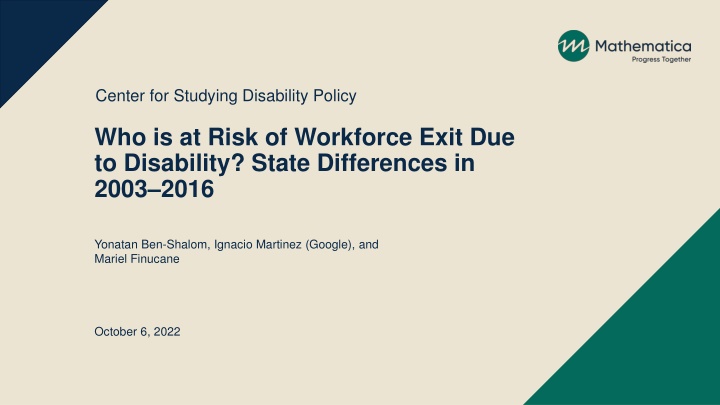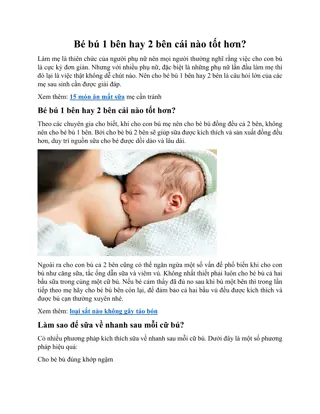
State Differences in Workforce Exit Due to Disability: Research Findings 2003-2016
Discover the latest study on workforce exit risks due to disability across states in 2003-2016. Explore the factors influencing trends, potential interventions, and state-level estimates. Funding provided by the Research and Training Center on Disability Statistics and Demographics at the University of New Hampshire.
Download Presentation

Please find below an Image/Link to download the presentation.
The content on the website is provided AS IS for your information and personal use only. It may not be sold, licensed, or shared on other websites without obtaining consent from the author. If you encounter any issues during the download, it is possible that the publisher has removed the file from their server.
You are allowed to download the files provided on this website for personal or commercial use, subject to the condition that they are used lawfully. All files are the property of their respective owners.
The content on the website is provided AS IS for your information and personal use only. It may not be sold, licensed, or shared on other websites without obtaining consent from the author.
E N D
Presentation Transcript
Center for Studying Disability Policy Who is at Risk of Workforce Exit Due to Disability? State Differences in 2003 2016 Yonatan Ben-Shalom, Ignacio Martinez (Google), and Mariel Finucane October 6, 2022
Funding for this study was provided by the Research and Training Center on Disability Statistics and Demographics at the University of New Hampshire, which is funded by the National Institute for Disability, Independent Living, and Rehabilitation Research in the Administration for Community Living at the U.S. Department of Health and Human Services (DHHS) under cooperative agreement 9ORTGE0001. The contents do not necessarily represent the policy of DHHS, and the reader should not assume endorsement by the federal government (EDGAR, 75.620 (b)). Center for Studying Disability Policy Center for Studying Disability Policy
Trends in workforce exit due to disability vary across states and subgroups Understanding these trends can help policymakers identify factors associated with increased risk, design timely interventions to help State-level estimates are often too noisy , even in large surveys Bayesian techniques can produce precise state-level estimates of trends in workforce exit due to disability Center for Studying Disability Policy 3
Key definitions and research questions Key definitions - Newly at-risk: employed in one month, out of labor force because of a disability in next month* - At-risk rate: share of newly at-risk in working-age population Research questions - How does at-risk rate vary across states, time, demographics? - How do at-risk rates compare to SSDI/SSI application, award rates? *Builds on Hollenbeck (2015). Center for Studying Disability Policy 4
Data Current Population Survey (CPS) - Basic monthly CPS for 2003 2016 - Civilian respondents ages 18 64 who completed first or fifth month in sample American Community Survey (ACS) - 1-year ACS data for 2003 2016 SSA data on applications and awards - National and state-level information about initial claims for disability benefits Center for Studying Disability Policy 5
Raw at-risk rates for subgroups Identifying newly at-risk CPS respondents - Employed in month 1 or 5, out of labor force because of a disability in month 2 or 6, respectively - Due to CPS rotation pattern, each respondent included only once per calendar year Calculating raw at-risk rates for each subgroup - Subgroups defined by year, state, age, gender, race, ethnicity, education - Raw at-risk rate is proportion of respondents in subgroup who are newly at risk Center for Studying Disability Policy 6
Improving precision of and reducing bias Improving precision (the MR in MRP) - Use weighted average of (noisy) raw subgroup estimates, nationwide estimate - Data determines how much information to borrow across subgroups Reducing bias (the P in MRP) - Alternative strategy for adjusting survey data to match U.S. population - Assigns weights for cells based on ACS instead of CPS - State, other estimates for subgroups are weighted average over cells in subgroup Center for Studying Disability Policy 7
Nationally, monthly at-risk rate has fluctuated between 15 and 20 per 10,000 Notes: This figure shows annual times series for the monthly at-risk rate (per 10,000 working-age adults) using Bayesian and classical methods. For the MRP series, the shaded area shows a 75 percent credible interval, which can be directly interpreted as having a 75 percent probability of containing the true at-risk rate. Center for Studying Disability Policy 8
For states, MRP estimates substantially more stable than classical Notes: This figure shows annual times series for the monthly at-risk rate (per 10,000 working-age adults) using MRP and classical methods for the smallest and largest states (based on population ages 18 to 64). For the MRP series, the shaded area shows a 75 percent credible interval, which can be directly interpreted as having a 75 percent probability of containing the true at-risk rate. Center for Studying Disability Policy 9
How demographic factors relate to at-risk rate Notes: This figure shows adjusted estimates of the monthly at-risk rate (per 10,000 working-age adults) using MRP methods, by demographic characteristics, holding all other demographic characteristics constant at national values for 2003. For each series, the shaded area shows a 75 percent credible interval, which can be directly interpreted as having a 75 percent probability of containing the true at-risk rate. Center for Studying Disability Policy 10
Nationally, at-risk rate is about 50 percent higher than SSDI/SSI application rate Notes: This figure shows unadjusted time series for the monthly at-risk rate using MRP methods, and SSDI/SSI application and award rates based on published SSA data. All rates are per 10,000 working-age adults. For the MRP series, the shaded area shows a 75 percent credible interval, which can be directly interpreted as having a 75 percent probability of containing the true at-risk rate. Center for Studying Disability Policy 11
States with temporary disability insurance (TDI) have high at-risk rates relative to non-TDI neighbors This figure shows unadjusted time series for the monthly at-risk rate using MRP methods, and SSDI/SSI application and award rates based on published SSA data, for two STDI states (California, New Jersey) and their non-TDI neighbors (Oregon, Pennsylvania). All rates are per 10,000 working-age adults. For the at-risk series, the shaded area shows a 75 percent credible interval, which can be directly interpreted as having a 75 percent probability of containing the true at-risk rate. Center for Studying Disability Policy 12
In disability belt, SSDI/SSI application rates are close to at-risk rate Notes: This figure shows unadjusted time series for the monthly at-risk rate using MRP methods, and SSDI/SSI application and award rates based on published SSA data, for disability belt states in Appalachia, the mid-South, and the Mississippi Delta. All rates are per 10,000 working-age adults. For the at-risk series, the shaded area shows a 75 percent credible interval, which can be directly interpreted as having a 75 percent probability of containing the true at-risk rate. Center for Studying Disability Policy 13
Summary MRP produces fairly precise yearly estimates of monthly at-risk rates - Compared to classical approach, state estimates much more stable using MRP - Demonstrates advantage of MRP in borrowing strength across states, time, subgroups Relationship between state at-risk rate and SSDI/SSI application rate varies considerably by state Center for Studying Disability Policy 14
Policy implications TDI might provide support buffer to workers at-risk of long-term disability Lack of supports in disability belt states might be contributing to high levels of SSDI/SSI applications Analysis of at-risk rates for subgroups (instead of states) can help understand differential effects of recession, pandemic Center for Studying Disability Policy 15
Citation Ben-Shalom, Yonatan, Ignacio Martinez, and Mariel McKenzie Finucane. Who Is at Risk of Workforce Exit Due to Disability? State Differences in 2003-2016. Journal of Survey Statistics and Methodology, vol. 9, no. 2, 2021, pp. 209-230. Center for Studying Disability Policy 16
For more information Yonatan Ben-Shalom YBen-Shalom@Mathematica-mpr.com Twitter: @BenShalomY Center for Studying Disability Policy 17






















